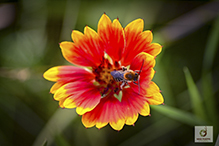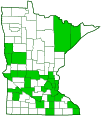dark-veined longhorn bee
(Melissodes trinodis)
Conservation • Description • Habitat • Biology • Distribution • Taxonomy
Conservation Status |
|
|||||||
| IUCN Red List | not listed |
|||||||
| NatureServe | NNR - Unranked SNR - Unranked |
|||||||
| Minnesota | not listed |
|||||||
Description |
||
Dark-veined longhorn bee is a hairy, medium-sized, late season, longhorn bee. It occurs in the United States from Maine to Georgia, west to North Dakota and eastern Kansas, and in adjacent Canadian provinces. There are also several records in the south and a small handful of records in the west. It appears late in the season, from July to October, when its preferred hosts are in bloom and competition from other bee species is reduced. It feeds on nectar and pollen mostly from sunflowers but also from several other species in the Aster (Asteraceae) family and a few species from other families. Females are 7⁄16″ to ½″ (11 to 12 mm) in length. The body is robust and almost entirely black. The head is as wide as the thorax and is densely covered with long, more or less erect, bright reddish-yellow or yellowish-orange hairs. The plate on the face (clypeus) is entirely black, is not lobed, and sticks out very slightly. Near the inner margin of each compound eye there is a row of stiff hairs that stick straight up. The top of the head is flat, not rounded, causing the simple eyes (ocelli) to bulge out. The upper side of the jaws (mandibles) are more or less yellowish or orange. The antennae are black above, pale on the underside. They have 12 segments, a long scape at the base, a short pedicel, and a whip-like section (flagellum) with 10 segments (flagellomeres). The first flagellomere is about half as long as the second. The thorax is densely covered with long, more or less erect, bright reddish-yellow or yellowish-orange hairs. The small plate on each side above the base of the wing (tegula) is tapered on one side, giving it a tear-drop shape. This is a defining feature of the genus Melissodes, but it is hidden beneath long hairs and cannot be seen without scraping the hairs away. The first abdominal segment has a few dark hairs on the side but is otherwise hairless. Segments 2 through 4 have a band of brownish-yellow hairs at the base and on the lateral margins. Segments 5 and 6 are covered with long black hairs but have some brownish-yellow hairs at the base. The legs are black and hairy. The pollen-collecting hairs (scopa) on the fourth segment (tibia) of the hind leg are yellowish or orangish and are densely feather-like (plumose). Males are smaller, ⅜″ to 7⁄16″ (9 to 11 mm) in length. The antennae have 13 segments and are extremely long. The underside of the flagellum is brownish brick-red. The clypeus is entirely yellow. There is a pair of robust spines at the base of the seventh abdominal segment. There is no scopa on the hind legs. |
||
Size |
||
Female: 7⁄16″ to ½″ (11 to 12 mm) Male: ⅜″ to 7⁄16″ (9 to 11 mm) |
||
Similar Species |
||
Habitat |
||
|
||
Biology |
||
Season |
||
July to October |
||
Behavior |
||
|
||
Life Cycle |
||
|
||
Larva Food |
||
|
||
Adult Food |
||
Nectar and pollen, mostly from sunflowers |
||
Distribution |
||||
|
Sources |
|||
| 11/3/2022 | ||||
Occurrence |
||||
|
||||
Taxonomy |
|||
Order |
Hymenoptera (ants, bees, wasps, and sawflies) | ||
Suborder |
Apocrita (narrow-waisted wasps, ants, and bees) | ||
Infraorder |
Aculeata (ants, bees, and stinging wasps) | ||
Superfamily |
Apoidea (bees and apoid wasps) | ||
| Epifamily | Anthophila (bees) | ||
Family |
Apidae (honey bees, bumble bees, and allies) | ||
Subfamily |
Apinae (apine bees) | ||
Tribe |
Eucerini (longhorn bees) | ||
Genus |
Melissodes | ||
| Subgenus | Eumelissodes | ||
Synonyms |
|||
|
|||
Common Names |
|||
dark-veined longhorn dark-veined longhorn bee three-knotted long-horned bee |
|||
Glossary
Clypeus
On insects, a hardened plate on the face above the upper lip (labrum).
Flagellomere
A segment of the whip-like third section of an insect antenna (flagellum).
Ocellus
Simple eye; an eye with a single lens. Plural: ocelli.
Scopa
A brush-like tuft of hairs on the legs or underside of the abdomen of a bee used to collect pollen.
Tegula
A small, hardened, plate, scale, or flap-like structure that overlaps the base of the forewing of insects in the orders Lepidoptera, Hymenoptera, Diptera, and Homoptera. Plural: tegulae.
Tibia
The fourth segment of an insect leg, after the femur and before the tarsus (foot). The fifth segment of a spider leg or palp.
Visitor Photos |
|||||
Share your photo of this insect. |
|||||
| This button not working for you? Simply email us at info@MinnesotaSeasons.com. Attach one or more photos and, if you like, a caption. |
|||||
Mike Poeppe |
|||||
 |
|||||
MinnesotaSeasons.com Photos |
|||||
|
|||||

Slideshows |
||
| Melissodes trinodis USGS Bee Inventory and Monitoring Lab |
||
 |
||
| Melissodes trinodis Isaacs Lab at MSU |
||
 |
||

Visitor Videos |
|||
Share your video of this insect. |
|||
| This button not working for you? Simply email us at info@MinnesotaSeasons.com. Attach a video, a YouTube link, or a cloud storage link. |
|||
Other Videos |
|||

Created: 11/3/2022
Last Updated:


